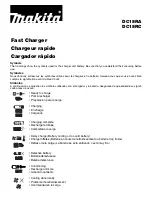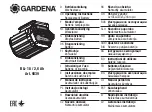
MCC-070 Controlled Charger
Midtronics BV Hoofdveste 6-8 3992 DG Houten
www.midtronics.com
7
General Safety Precautions
4.3 An extension cord should not be used unless absolutely
necessary. Use of an improper extension cord could result
in a risk of fire and electric shock. If an extension cord must
be used, make sure:
a. that the pins on plugs of the extension cord are the
same number, size, and shape as those of the plug on
the charger;
b. that the extension cord is properly wired and in good
electrical condition;
c. that the wire size is large enough for the AC ampere
rating of charger as specified in the following table.
Recommended minimum AWG* size
for extension cords for battery chargers
AC input rating Amps
AWG* size of cord
Equal or
greater than:
But less
than:
Length of cord, feet (m)
25 (7.6) 50 (15.2) 100 (30.5)150 (45.6)
8
10
18
14
12
10
10
12
16
14
10
8
12
14
16
12
10
8
14
16
16
12
10
8
16
18
14
12
8
8
*American Wire Gauge
5 Charger Location
Not for permanent installation: Modifying this charger for
permanent installation in a vehicle or installing this charger in
a vehicle for permanent use is not recommended.
In the event of fail device may generate
and emit sparks.
Only charge rechargeable flooded maintenance-
free, low-maintenance or deep-cycle batteries.
This charger is not designed outside use or for wet location
mounting. The charger must always be protected from direct
contact with water.
ALWAYS use in the horizontal position or mounted securely to
the stabilizing base.
5.1 The charger must be located in an area with sufficient air
space to allow unrestricted airflow in and around the charger.
5.2 Locate the charger as far away from the battery as the
charger cables permit.
5.3 Never place the charger directly above the battery being
charged; gases from the battery will corrode and damage
the charger.
5.4 Never allow battery acid to drip on the charger when tak-
ing gravity readings or filling a flooded cell battery.
5.5 Operate the charger only in a well-ventilated area that is
free of dangerous vapors.
5.6 Store the charger in safe, dry location and maintain it in
perfect condition.
5.7 Do not set the battery on top of the charger or where its
acid might drip onto the charger.
6 DC Connection Precautions
6.1 Connect and disconnect the charger clamps only after the
charger has been turned off and the AC supply cord is dis-
connected from the electric outlet.
6.2 Never allow the charger clamps to touch each other.
6.3 When attaching the charger clamps, be certain to make the
best possible mechanical as well as electrical connection.
This will tend to prevent the clamps from slipping off the
connections, avoid dangerous sparking, and assure safer and
more efficient charging. The clamps should be kept clean.
Hazardous voltage.
Can cause death or serious
personal injury.
Setting the switches to “OFF” does not always
disconnect the charger electrical circuit from
the AC power cord or the DC charger clamps.
7 Installing The Battery
Risk of explosive gases.
Prevent flames and sparks. Provide adequate ventilation
during charging.
7.1 Locate the charger as far away from the battery as the
charger cords permit and position the AC and DC cords to
avoid stepping on or tripping over them and to prevent
damage by moving engine parts.
7.2 Turn OFF all vehicle loads, including door lights, and cor-
rect any defects in the vehicle’s electrical system that may
have caused low battery.
7.3 First connect the POSITIVE (RED) clamp from the charger
to the POSITIVE (POS., P, +) ungrounded post of the bat-
tery. Then connect the NEGATIVE (BLACK) clamp to the
NEGATIVE (NEG., N,–) post of the battery. Do not con-
nect the clamp to the carburetor, fuel lines, or sheet-metal
body parts.








































